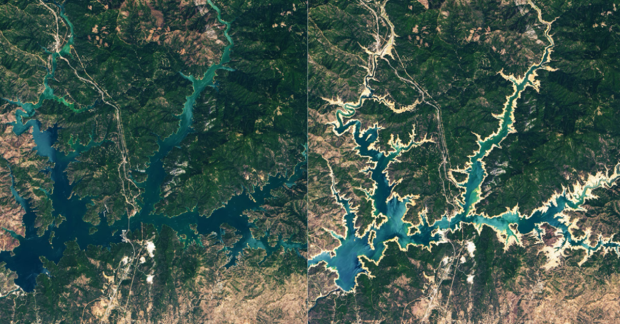Problem Statement
The western US suffers from long and persistent droughts. In California, severe droughts threaten important water resources for cities, farmers and ecosystems. In California’s climate, the Sierra Nevada mountain snowpack is a critical source of water through the dry summers. There is much ongoing research trying to increase water yield by retaining snowpack and forest management strategies to limit evaporative demand. Recognizing that trade-offs exist between providing water for downstream users and preserving sufficient water for headwater ecosystems, water resource managers must balance these requirements when considering allocations during drought.
In order to meet the needs of aquatic ecosystems, recreational users, agriculture, and municipalities, the California Wildlife Conservation Board has asked for recommendations about how to increase summer streamflow in sensitive watersheds. Students are asked to address the problem: How can we incorporate management actions to modify the terrestrial water budget to mitigate drought stress? Students conduct a historical low-flow analysis in observed data, and use an ecohydrological model to evaluate sensitivity of components of the terrestrial water budget to drought.
Module Overview
This module will examine individual components of the terrestrial water budget using empirical analysis of observed precipitation and streamflow. These data will then be fed into the ecohydrologic model RHESSys to conduct exploratory model scenario analysis of the water budget. Incorporating model calibration and uncertainty estimation simulates an authentic, real-world scenario of model evaluation and application. The model scenario analysis will provide recommendations for the Wildlife Conservation Board on how to modify the terrestrial water budget to increase summer streamflow.
Topics Covered
- Time-series analysis
- Model calibration
- Model uncertainty estimation
- Parameter sensitivity analysis
Prerequisites
Students should be able to recognize fundamental components of the hydrological cycle, describe processes of rainfall-runoff generation, and recognize statistics used for hydrologic model evaluation. The HydroLearn module Physical Hydrology may be helpful to students to obtain this knowledge. Students should also be comfortable with Python and computer programming in Jupyter notebooks.
Learning Objectives
At the end of this module, students will be able to: use Python to analyze historical precipitation and streamflow data to examine components of the terrestrial water balance, use the RHESSys model to conduct scenario analysis examining sensitivity of hydrologic processes to subsurface and vegetation characteristics in the model, and calculate and evaluate hydrological model performance metrics with Python's hydroeval package.
This will be accomplished through activities within each section. Results from each activity will be recorded in specified results templates. The results templates for each activity can be found at the beginning of each activity. The results templates are organized such that results from one activity can easily be used in successive activities.
Course Authors
Louis Graup
Louis Graup is a PhD candidate in the Bren School of Environmental Science and Management at University of California Santa Barbara. His research focuses on using ecohydrological models to quantify spatial patterns of ecosystem response to climate change.
lgraup@ucsb.edu
Dr. Anne Lightbody
Anne Lightbody is an Associate Professor of surface-water hydrology in the Department of Earth Sciences at the University of New Hampshire. She earned a BS and MS in Biology from yale University, and MS and PhD in Civil and Environmental Engineering from the Massachusetts Institute of Technology. Her research and teaching focus on hydrodynamics and hydrology of river networks.
anne.lightbody@unh.edu
Kazi Tamaddun, PhD, MBA
Kazi Tamaddun is an Applied Scientist (Hydroclimalogy) at the U.S. Department of Energy's Pacific Northwest National Laboratory (PNNL). Kazi obtained his B.Sc. in Civil and Environmental Engineering from Bangladesh University of Engineering and Technology. He received his M.Sc. and Ph.D. in Civil and Environmental Engineering from the University of Nevada, Las Vegas. Before joining PNNL, Kazi worked as a Postdoctoral Research Associate at the University of Virginia where he worked for the Resilient Urban Water Systems research group. Kazi is currently working on his post graduate degree in Artificial Intelligence and Machine Learning from the University of Texas at Austin. Kazi also holds an MBA from the University of Dhaka with an interest in data driven market research.
kat6am@virginia.edu
Solution Keys
To obtain solution keys for the learning activities embedded in the module, contact the authors.
Target Audience
Upper division undergraduates or early graduate students
Course Sharing and Adaptation
This course is available for export by clicking the "Export Link" at the top right of this page. You will need a HydroLearn instructor studio account to do this. You will first need to sign up for a hydrolearn.org account, then from your edX Dashboard request the ability to create courses.
This module is well-suited to implementation as individual components in a class, rather than using the entire module. Instructors who want their students to become familiar with retrieval and analysis of hydrological data could adapt section 1, while section 2 is suitable for students who are familiar with observed data, but need an introduction to hydrological model evaluation and application. Although section 2 uses the RHESSys model to explore model sensitivity analysis, this section could be easily adapted to utilize any hydrology model.
Expected Effort
The module developers estimate that this module will take between 10 to 14 hours to complete.




